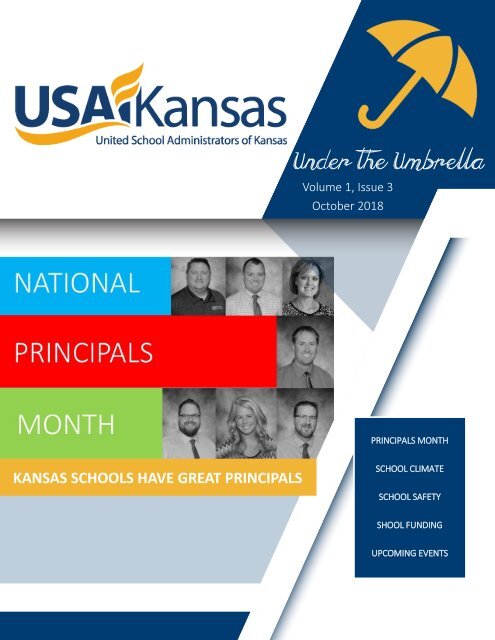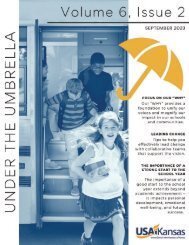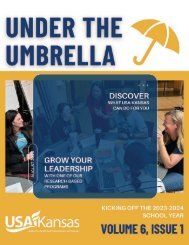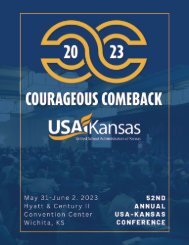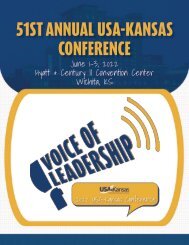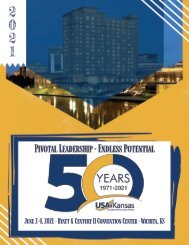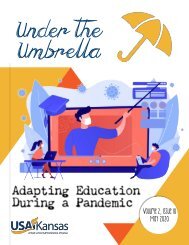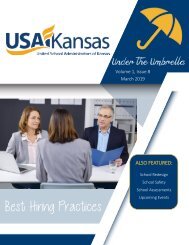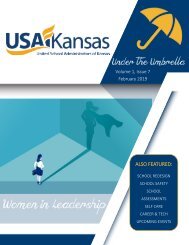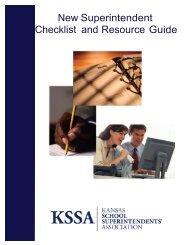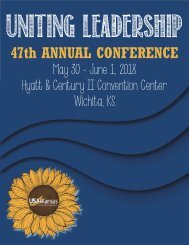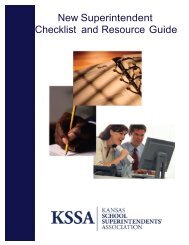Under the Umbrella Volume 1, Issue 3
You also want an ePaper? Increase the reach of your titles
YUMPU automatically turns print PDFs into web optimized ePapers that Google loves.
<strong>Under</strong> <strong>the</strong> <strong>Umbrella</strong><br />
<strong>Volume</strong> 1, <strong>Issue</strong> 3<br />
October 2018<br />
PRINCIPALS MONTH<br />
KANSAS SCHOOLS HAVE GREAT PRINCIPALS<br />
SCHOOL CLIMATE<br />
SCHOOL SAFETY<br />
SHOOL FUNDING<br />
UPCOMING EVENTS
CONTENTS <strong>Volume</strong> 1, <strong>Issue</strong> 3<br />
2 Avoiding <strong>the</strong> Inbox, G.A. Buie<br />
3 Celebrating <strong>the</strong> Principalship Nationwide<br />
SCHOOL REDESIGN<br />
4 Mission Clarity—Your Mission Drives Your Outcomes,<br />
Dr. John Vandewalle<br />
5 Coffeyville Public Schools Discuss Redesign, Dr. Craig<br />
Correll, and Coffeyville Principals<br />
SCHOOL SAFETY<br />
7-8 Look Out, Lock Out, Lock Down!, Doug Parisi<br />
8 Do Schools’ Active Shooter Drills Prepare or Frighten?, Evie<br />
Blad<br />
SCHOOL CLIMATE & CULTURE<br />
10-11 Your Job? Helping Teachers Grow, Mark Wilson<br />
12 Staying Positive in <strong>the</strong> School Year, Jerry Henn<br />
13-15 The Overlapping Worlds of Work and Education, Sandy<br />
Husk<br />
15 Administrators Can Make or Break School Culture. How to<br />
Spot <strong>the</strong> Best Ones, Mary Alicia Lyons<br />
SCHOOL FUNDING<br />
16 Facts About Administrator Salaries, G.A. Buie, Mark Tallman<br />
SCHOOL ASSESSMENTS<br />
18-19 Everybody in <strong>the</strong> Pool—How Pool Depth Affects<br />
Assessment Accuracy, April Roe<strong>the</strong>l<br />
22-23 Upcoming Events<br />
NETWORK & STAY CONECTED<br />
@USAKansas<br />
Facebook.com/USAKansas<br />
2018-2019 USA-Kansas<br />
Board of Directors<br />
Sean Cochran—President, KASEA<br />
Ryan Jilka—President Elect, KAMSA<br />
Pete Bastian—Past-President, KAESP<br />
Mike Berblinger—Director, KSSA<br />
Cory Gibson—Director, KSSA<br />
Eric Hensen—Director, KASBO<br />
Volora Hanzlicek—Director, KASCD<br />
Ron Barry—Director, KASSP<br />
Justin Henry—Director, KSSA<br />
Kristin Magette—Director, KanSPRA<br />
Christie Meyer—Director, KASCD<br />
Bert Moore—Director, KASEA<br />
Suzan Patton—Director, KSSA<br />
Dennis Peerenboom—Director, KASPA<br />
P.J. Reilly—Director, KCCTEA<br />
Donna Schmidt—Director, KASSP<br />
Glen Suppes—Director, KSSA<br />
Patrick Schroeder—Director, KAESP<br />
Donna Zerr—Director, KASSP<br />
G.A. Buie—Executive Director<br />
Jerry Henn—Assistant Executive Director
AVOIDING THE INBOX<br />
G.A. Buie, Executive Director, USA-Kansas<br />
As a school administrators,<br />
your inbox can be a<br />
dumping ground for priority<br />
information, valuable<br />
information, useful<br />
information, and junk!<br />
You’re inundated daily with<br />
messages from a variety of sources and often <strong>the</strong><br />
important gets mixed among <strong>the</strong> trash. Key<br />
information is deleted without ever seeing <strong>the</strong><br />
message. Or maybe you plan to deal with <strong>the</strong><br />
message later in <strong>the</strong> day or <strong>the</strong> week but <strong>the</strong><br />
message gets lost in your inbox. I understand your<br />
pain, plus I (USA-Kansas) also understand we are<br />
one of <strong>the</strong> organizations contributing to <strong>the</strong> clutter<br />
in your inbox.<br />
We believe we have developed a solution, but we<br />
need your help to make it successful. Through<br />
<strong>the</strong> new USA-Kansas Mobile App we can push<br />
information to you without ever touching your<br />
email, more importantly <strong>the</strong> messages are<br />
archived so you can read <strong>the</strong> message at your<br />
leisure and never have to worry about losing<br />
messages among <strong>the</strong> 100’s of o<strong>the</strong>r messages you<br />
deal with daily. If you are a member or not, please<br />
consider downloading <strong>the</strong> “USAK” mobile app for<br />
your mobile device, and help use leave email<br />
messages in <strong>the</strong> past!<br />
Download <strong>the</strong> USA-Kansas App!<br />
To maximize your communication with USA-Kansas without inundating your Inbox, please download <strong>the</strong> USAK<br />
App and allow push notifications. This is a great tool to ga<strong>the</strong>r valuable information from <strong>the</strong> USA-Kansas office<br />
regarding legislative activities, education news around <strong>the</strong> state, job openings, and updates on USA-Kansas<br />
events. Take a few minutes today and set up your membership's organizational App.<br />
Search for USAK in <strong>the</strong> app<br />
store or use this QR code for<br />
fast access!<br />
2
CELEBRATING THE PRINCIPALSHIP NATIONWIDE<br />
and it is <strong>the</strong>ir vision, dedication, and determination<br />
that provide <strong>the</strong> mobilizing force for achieving<br />
student success. Each October, NASSP, NAESP, and<br />
AFSA seek to honor <strong>the</strong>se unsung heroes for <strong>the</strong>ir<br />
tireless efforts in pursuit of excellence in education.<br />
Each October, National Principals Month recognizes<br />
<strong>the</strong> essential role that principals play in making a<br />
school great.<br />
National Principals Month is your opportunity to say<br />
“thank you” to principals everywhere and to share<br />
with <strong>the</strong> community all <strong>the</strong> great things that<br />
principals do.<br />
Principals set <strong>the</strong> academic tone for <strong>the</strong>ir schools,<br />
National Principals Month is a widely recognized<br />
celebration of <strong>the</strong> principalship, marked by national<br />
and state resolutions supporting <strong>the</strong> event, as well as<br />
acknowledgements from U.S. Senators and<br />
Representatives, and top government officials.<br />
However, <strong>the</strong> most important National Principals<br />
Month celebrations are <strong>the</strong> ones that take place in<br />
schools and communities across <strong>the</strong> country.<br />
Visit www.principalsmonth.org soon for more<br />
information about National Principals Month 2018!<br />
3
SCHOOL REDESIGN<br />
MISSION CLARITY—YOUR MISSION DRIVES YOUR OUTCOMES<br />
By Dr. John Vandewalle, CEO Lumen Touch<br />
On <strong>the</strong> 25th of May, 1961 John F.<br />
Kennedy stood before Congress and<br />
proposed that <strong>the</strong> US "should<br />
commit itself to achieving <strong>the</strong> goal,<br />
before this decade is out, of landing<br />
a man on <strong>the</strong> Moon and returning<br />
him safely to <strong>the</strong> Earth."<br />
With this statement Kennedy's gave <strong>the</strong> mission to NASA's<br />
Apollo program.<br />
Remember <strong>the</strong> shocking launch of Sputnik 1 in October<br />
1957 and to boot <strong>the</strong> 1961 flight of Soviet cosmonaut Yuri<br />
Gagarin. We realized <strong>the</strong>n that we were losing <strong>the</strong> race.<br />
We had a crisis/challenge on our hands and leadership<br />
that took it head on.<br />
This mission was started with <strong>the</strong> Gemini and Mercury<br />
programs followed by <strong>the</strong> Apollo program that<br />
impregnated July 20 th , 1969 in our minds, on television<br />
screens and in <strong>the</strong> history books when we landed Apollo<br />
11 on <strong>the</strong> moon.<br />
Mission accomplished in less than 10 years with what pride<br />
and scientific prowess.<br />
So let us dissect this vignette and see where it is<br />
applicable to our education endeavors.<br />
A look at mission statements of schools/districts outside<br />
of Kansas gives us <strong>the</strong> opportunity of reflecting.<br />
District Mission Statement. In partnership with <strong>the</strong><br />
community and its students, <strong>the</strong> School District of Bloomer<br />
is committed to excellence by empowering and challenging<br />
all students to achieve <strong>the</strong>ir potential as life-long learners in<br />
an ever-changing global society.<br />
Our Mission: Catalina Foothills School District, a caring and<br />
collaborative learning community, ensures that each<br />
4<br />
student achieves intellectual and personal excellence, and is<br />
well prepared for college and career pathways.<br />
Princeton Academy: Our mission is to develop young men<br />
with active and creative minds, a sense of understanding<br />
and compassion for o<strong>the</strong>rs, and <strong>the</strong> courage to act on <strong>the</strong>ir<br />
beliefs. We stress <strong>the</strong> total development of each child:<br />
spiritual, moral, intellectual, social, emotional, and physical.<br />
Based on <strong>the</strong>se do you see similarities? Compare and<br />
contrast <strong>the</strong>se with your mission and <strong>the</strong> mission set by<br />
John F. Kennedy.<br />
So, one may ask “what are <strong>the</strong> components of a good<br />
mission statement?” before we discuss <strong>the</strong> huge<br />
importance of your mission statement.<br />
Your mission statement should be short, clear, vivid,<br />
inspiring and concise.<br />
The most successful Mission Statements are inspiring,<br />
powerful and compelling.<br />
So, do your own assessment on your school/district<br />
mission statement. Is your mission,<br />
Clear, concise, memorable, repeatable<br />
Motivational to drive action<br />
A depiction of <strong>the</strong> short-term future – imagine<br />
2 to 5 years from now<br />
Has clearly defined success<br />
See how <strong>the</strong> mission laid out by JFK fits <strong>the</strong> criteria above.
COFFEYVILLE PUBLIC SCHOOLS DISCUSS<br />
REDESIGN<br />
Dr. Craig Correll, Superintendent, Coffeyville Public Schools<br />
Coffeyville leads <strong>the</strong> world in <strong>the</strong> success of each<br />
student and along <strong>the</strong> way, provides a model to<br />
o<strong>the</strong>r districts. I would like to highlight <strong>the</strong><br />
tremendous changes that have already begun to<br />
take place in Coffeyville and shine a light on our<br />
students, staff and community as leaders in <strong>the</strong><br />
education of a town. We are not just Coffeyville<br />
Public Schools, we are Coffeyville’s Public Schools.<br />
As far as what we want to accomplish, I go back to<br />
Coffeyville leading <strong>the</strong> world in <strong>the</strong> success of each<br />
student. We will do this by dedicating ourselves to<br />
areas in which we have already seen success such as<br />
Kindergarten Readiness, emphasizing Social/<br />
Emotional needs and ensuring <strong>the</strong> success of<br />
students after graduation.<br />
Kindergarten Readiness<br />
Coffeyville has proven our effectiveness in this area<br />
by establishing public/private partnerships and with<br />
a community that understands <strong>the</strong> importance of<br />
high quality early education.<br />
Our elementary teachers have already seen <strong>the</strong><br />
impact our early learning center is having on our<br />
students.<br />
Social/Emotional<br />
We are <strong>the</strong> only school district in <strong>the</strong> state of Kansas<br />
that has fully staffed medical/mental health/dental<br />
clinics located inside our school campuses. This<br />
partnership has resulted in a number of benefits to<br />
our students in immunizations, attendance and<br />
behavior. While already unique, our new vision<br />
moves beyond just a clinic. We plan to create a first: a<br />
true intersection of education and health to deal with<br />
<strong>the</strong> persistent toxic stress our students and<br />
community have endured.<br />
Post-Secondary<br />
We are fortunate to have Coffeyville Community<br />
College on campus and such willing partners in<br />
helping to prepare our students for careers beyond<br />
school. Flipping <strong>the</strong> model for students, students can<br />
not only receive college credit for high school classes,<br />
but are now receiving high school credit for college<br />
courses.<br />
CLICK HERE to read Coffeyville Principals’ accounts of<br />
<strong>the</strong> redesign process in <strong>the</strong>ir buildings.<br />
5
SCHOOL SAFETY<br />
LOOK OUT, LOCK OUT, LOCK DOWN!<br />
Doug Parisi, SafeDefend<br />
Schools across <strong>the</strong> country are<br />
working on protocols to address<br />
<strong>the</strong> events that have a potential to<br />
compromise safety for students<br />
within <strong>the</strong> building. While adding<br />
ano<strong>the</strong>r mantra to <strong>the</strong> litany of<br />
policies and procedures isn’t <strong>the</strong> most popular idea,<br />
<strong>the</strong>re is a need to differentiate <strong>the</strong> varied response<br />
options needed for notification. It is vital that we<br />
communicate to staff <strong>the</strong> potential for problems<br />
based on outside information and that proper<br />
training be implemented to explain expectations if<br />
initiated.<br />
There are events that happen in<br />
and around our schools that<br />
require a heightened level of<br />
awareness with no real need to<br />
change <strong>the</strong> day to day<br />
procedures. After 911 we saw<br />
<strong>the</strong> color-based threat level from<br />
green to red implemented for<br />
public consumption. In our<br />
schools a similar approach should be added. A<br />
simple email or personal briefing to staff can inform<br />
<strong>the</strong>m of domestic/custody issues among parents of<br />
students, staff that might have a protection from<br />
abuse or stalking, divorce issues or even police<br />
notifications about crime trends or suspicious activity<br />
near <strong>the</strong> school that can manifest on campus. Letting<br />
teachers know that <strong>the</strong>re is a threat brings a greater<br />
awareness to being aware of persons entering <strong>the</strong><br />
building or vehicles in <strong>the</strong> lots. With increased<br />
awareness comes greater scrutiny which in turn can<br />
enhance intervention. The importance is notifying<br />
your most vital resource, <strong>the</strong> human assets in <strong>the</strong><br />
building, that <strong>the</strong>re is a potential for trouble.<br />
When trouble arises in <strong>the</strong> community or away<br />
from <strong>the</strong> building but <strong>the</strong>re is a connection to <strong>the</strong><br />
school <strong>the</strong>n precautionary steps should be<br />
implemented. Locking <strong>the</strong> building down enhances<br />
security and allows for a reactionary time by<br />
responders. Any time law enforcement is working a<br />
serious event within a geographic proximity to <strong>the</strong><br />
campus, a parent has made a threat indication <strong>the</strong>y<br />
are intending on causing a scene, anonymous<br />
threats are received via phone, email or left note,<br />
or suspicious person/activity is noticed in <strong>the</strong> area<br />
<strong>the</strong> building should go into ‘lock out’. This should<br />
mean that all visitors are prohibited from entering<br />
unless it is a scheduled event and <strong>the</strong> person must<br />
be met at <strong>the</strong> door and escorted inside. The<br />
students will continue to move throughout <strong>the</strong><br />
building and recess can be scheduled in <strong>the</strong> gym.<br />
For modular units <strong>the</strong> doors shall be locked and <strong>the</strong><br />
students escorted in and out of <strong>the</strong> building. This<br />
lock out is intended to heighten <strong>the</strong> attention of <strong>the</strong><br />
staff to a possible threat that can be identified to a<br />
specific event. It should have a limited time frame<br />
and <strong>the</strong> staff should be notified why <strong>the</strong> steps are<br />
being taken and <strong>the</strong> duration. A simple email can<br />
accomplish this stating <strong>the</strong> reason (police notified<br />
us of a felon in <strong>the</strong> area) and <strong>the</strong> expected time for<br />
<strong>the</strong> procedure to end. A follow up email should<br />
always be sent stating normal procedures are back<br />
in effect and include as much known information<br />
about <strong>the</strong> incident. (parent was contacted and<br />
situation resolved, police gave <strong>the</strong> all clear, <strong>the</strong><br />
suspicious person was a politician handing out<br />
lollipops) The critical component is communication<br />
to staff.<br />
7
Most schools have a current lock down in place. A<br />
consideration for <strong>the</strong>se policies is to include a<br />
modified lockdown which keeps <strong>the</strong> children in <strong>the</strong><br />
classroom but not barricaded in <strong>the</strong> safe corner. This<br />
is used for things like police chases that end in <strong>the</strong><br />
area or when police are called to handle an issue<br />
such as a large fight or disgruntled parent. Generally,<br />
<strong>the</strong>se events can be announced over <strong>the</strong> public<br />
address, radio or personal notification. When I talk<br />
with administrators about how to issue an all clear<br />
after a modification I strongly encourage <strong>the</strong><br />
presence of a uniformed law enforcement officers to<br />
be inside <strong>the</strong> building and seen in <strong>the</strong> hallways. The<br />
relief of seeing a clear sign of safety cannot be<br />
understated for <strong>the</strong> students that just experienced<br />
<strong>the</strong> higher than normal anxiety.<br />
The details of a lock down are well known to all<br />
administrators. Where we fail is in <strong>the</strong><br />
implementation and notification. A basic review of<br />
past gun, knife and violent attacks demonstrates that<br />
<strong>the</strong> vast majority of lock downs occur after <strong>the</strong><br />
incident is over. Ei<strong>the</strong>r <strong>the</strong> suspect has fled or <strong>the</strong><br />
attack was thwarted. In a crisis <strong>the</strong> need to quickly<br />
notify buildings occupants and responders<br />
simultaneously is <strong>the</strong> key to reducing casualties. We<br />
don’t use intercoms and radios for fire emergencies<br />
and we shouldn’t for violent intruders. An audible<br />
and visual alert should be easily activated in a crisis.<br />
In <strong>the</strong> three major incidents last Spring <strong>the</strong> lockdown<br />
was communicated verbally for <strong>the</strong> first five minutes.<br />
This failure resulted in unnecessary casualties and<br />
8<br />
In a crisis <strong>the</strong> need to quickly<br />
notify buildings occupants<br />
and responders<br />
simultaneously is <strong>the</strong> key to<br />
reducing casualties.<br />
loss of life. Adapting current non-emergency<br />
communication methods to a hostile intruder is<br />
ignoring <strong>the</strong> reality that <strong>the</strong>y rarely work in a crisis.<br />
Information is <strong>the</strong> key to reducing casualties. Being<br />
informed that <strong>the</strong>re is a potential for a crisis or an<br />
actual event in <strong>the</strong> building gives power to <strong>the</strong><br />
recipient to initiate steps for protection. The more<br />
people that are aware of <strong>the</strong> possibility of an issue<br />
<strong>the</strong> greatly likelihood violence can be thwarted and<br />
stopped.<br />
DO SCHOOLS’ ACTIVE<br />
SHOOTER DRILLS<br />
PREPARE OR FRIGHTEN?<br />
Evie Blad, Education Week<br />
On "safety days," elementary students in Akron,<br />
Ohio, learn a new vocabulary word: barricade.<br />
School-based police officers tell students as young<br />
as kindergartners how to stack chairs and desks<br />
against <strong>the</strong> classroom door to make it harder for<br />
"bad guys" to get in. "Make <strong>the</strong> classroom more like<br />
a fort," an officer says in a video of <strong>the</strong> exercise.<br />
If a teacher asks you to climb out a window, listen<br />
to <strong>the</strong>m, <strong>the</strong> officers instruct. And, in <strong>the</strong> unlikely<br />
event a "bad guy" gets into <strong>the</strong> classroom, scream<br />
and run around to distract him, officers tell<br />
students.<br />
For some parents, <strong>the</strong> idea of such instruction is<br />
chilling. O<strong>the</strong>rs, though, say it's a sad, but necessary<br />
sign of <strong>the</strong> times.<br />
CLICK HERE to view full story.
SCHOOL CLIMATE AND CULTURE<br />
YOUR JOB? HELPING TEACHERS GROW<br />
Mark Wilson, The Principal Matters<br />
Becoming a Principal can be<br />
a curious thing.<br />
You get <strong>the</strong> job before you<br />
know <strong>the</strong> job, and <strong>the</strong>n a big<br />
part of your job is to figure out what your job really<br />
is.<br />
Are you with me? Please let me explain.<br />
The expectations of <strong>the</strong> principal haven't changed<br />
over <strong>the</strong> years... instead, <strong>the</strong>y've multiplied! People<br />
still expect <strong>the</strong> principal do things <strong>the</strong>y've done for<br />
decades-- be <strong>the</strong> face of <strong>the</strong> school, support <strong>the</strong><br />
students at extracurricular events, open car doors in<br />
<strong>the</strong> morning and solve bus issues in <strong>the</strong> afternoon.<br />
And.<br />
And develop a comprehensive school improvement<br />
plan. And a hospitable culture to rival Chick-Fil-<br />
A. And infuse STEM, Mindset Training, and<br />
Differentiate for teachers and students alike.<br />
That's just a sliver of all of <strong>the</strong> things you're asked to<br />
do, as you know. But here's <strong>the</strong> challenge: out of <strong>the</strong><br />
many important things that you do, what's <strong>the</strong> most<br />
critical for you to do to live up to <strong>the</strong> standards set<br />
for your performance?<br />
Help your teachers grow.<br />
Yes, your responsibility for safety is always <strong>the</strong> most<br />
important thing you do, but <strong>the</strong> most critical for you<br />
to be deemed successful is to help your teachers<br />
grow.<br />
10<br />
It's for that reason everyone says you need to be<br />
visible. It's to help your teachers grow that you go<br />
to grade-level meetings, and PLCs, and book<br />
studies. It's <strong>the</strong> goal of your school's evaluation<br />
program. It's <strong>the</strong> most critical thing you do. In its<br />
absence, you are at best a caretaker of <strong>the</strong> school,<br />
not a leader. Our business is learning; our key<br />
representatives in <strong>the</strong> business are our<br />
teachers; <strong>the</strong>ir performance IS your<br />
performance. It is on this that you focus if you want<br />
your school to meet <strong>the</strong> needs of <strong>the</strong> students,<br />
because it's through your teachers that you reach<br />
out to each and every one of your students. Your<br />
heart and your head through <strong>the</strong>ir hands. Hands<br />
whose work YOU are responsible for.<br />
Your commitment to <strong>the</strong> task at hand-- leading your<br />
teachers in <strong>the</strong>ir professional growth-- is <strong>the</strong><br />
pathway to success for you, your teachers, your<br />
students, and your school. Using <strong>the</strong> evaluation<br />
system as a support and as a needs assessment,<br />
your role as <strong>the</strong> school leader is to find out what<br />
your people need and get it to <strong>the</strong>m. (Just as <strong>the</strong><br />
teacher's role is to do <strong>the</strong> same for her students!)<br />
I've heard school administrators tell <strong>the</strong>ir faculty<br />
members, "my job is to make your job<br />
easier," That's a notion worth a challenge. The<br />
truth is, <strong>the</strong> teacher's job isn't really easy, and while<br />
administrators offer support, our best play isn't to
present ourselves as Tech Support or <strong>the</strong> Geek<br />
Squad. Perhaps our goal should be to be more like<br />
Mr. Miyagi from The Karate Kid? A trusted, wise<br />
coach whose wisdom matches up with his authority.<br />
Making your teachers' jobs easier may be a lot to<br />
promise, but what if your focus is on helping your<br />
teachers find more meaning in <strong>the</strong>ir work? What if<br />
your "job' is to help <strong>the</strong>m learn so much about doing<br />
<strong>the</strong>ir job that <strong>the</strong>ir confidence stands taller than <strong>the</strong>ir<br />
troubles and <strong>the</strong>ir doubts? That's a lot more<br />
substantive and sustainable of a gift.<br />
As we enter September and <strong>the</strong> second phase of<br />
<strong>the</strong> school year, <strong>the</strong> performance of your teachers<br />
will become more and more an indicator of <strong>the</strong><br />
success of your students, AND your quality of life as<br />
<strong>the</strong> principal. Their growth is your job. Make sure<br />
your calendar reflects it as <strong>the</strong> priority that it is.<br />
11
As <strong>the</strong> new school year has begun,<br />
<strong>the</strong> anticipation of <strong>the</strong> upcoming<br />
school year is always<br />
exciting. Everyone is pumped to<br />
begin and <strong>the</strong>re is always that<br />
unknown factor that enters into <strong>the</strong><br />
school keeping hopes alive and<br />
nerves on edge. Wouldn’t it be nice if this excitement<br />
continued throughout <strong>the</strong> school year? Well it can if you<br />
allow it to.<br />
Here are some ideas for you to keep it fun and positive<br />
throughout <strong>the</strong> year.<br />
12<br />
STAYING POSITIVE IN<br />
THE SCHOOL YEAR<br />
Jerry Henn, Assistant Executive Director,<br />
USA-Kansas<br />
1. Treat <strong>the</strong> first of <strong>the</strong> month as a new start of <strong>the</strong><br />
school year. Maybe not to <strong>the</strong> scale as a new year, but<br />
open <strong>the</strong> doors with excitement.<br />
2. Greet students with a smile and keep all<br />
conversations positive. Any conversations that are not<br />
positive need to be taken care of in your office.<br />
3. Keep yourself organized. By keeping yourself<br />
organized will give you more time to talk with students<br />
and community.<br />
4. Surround yourself with positive people. In most<br />
cases <strong>the</strong> students are some of <strong>the</strong> most positive<br />
people in <strong>the</strong> building. Take time to enjoy <strong>the</strong> reason<br />
you chose education in <strong>the</strong> first place.<br />
5. Look towards <strong>the</strong> future, be optimistic. Deal with<br />
<strong>the</strong> negative as you must, but <strong>the</strong>n turn back to <strong>the</strong><br />
positive. Once an issue solved, it is time to be positive<br />
again.<br />
6. Most importantly, learn from your mistakes. You<br />
chose education because you are good with people<br />
and relationships; once you learn from your mistake,<br />
forget it and make sure you do not make <strong>the</strong> same<br />
mistake again. It will become a positive for you.<br />
These are items that have guided me through some<br />
rough times. I always had someone to talk with as well<br />
and <strong>the</strong>y can be <strong>the</strong>rapy for sure!<br />
Good luck in your school year and just remember, your<br />
students are counting on you to be <strong>the</strong>re for<br />
<strong>the</strong>m. Keep up <strong>the</strong> great work you do for <strong>the</strong> students<br />
of Kansas.<br />
COMMUNICATION<br />
CORNER<br />
When it comes to your staff team, do you know<br />
which employees parents trust most? Surveys show:<br />
Their child’s classroom teacher. And <strong>the</strong>ir child’s bus<br />
driver.<br />
Arming teachers with need-to-know information is<br />
usually routine. But your school’s support staff -- bus<br />
drivers, custodians, front office workers -- are likely<br />
some of <strong>the</strong> most visible people you have. Here are<br />
a few ideas to keep <strong>the</strong>m engaged all year:<br />
• Make sure ALL staff -- not just teachers -- get<br />
essential information about your school.<br />
• Urge support staff to make suggestions and<br />
share ideas. Be sure to listen.<br />
• Offer <strong>the</strong>se team members professional<br />
development opportunities.<br />
• Ride on a school bus occasionally to understand<br />
<strong>the</strong> challenges of drivers and show you care<br />
about <strong>the</strong>ir concerns.<br />
• Recognize <strong>the</strong>ir contribution with thank you<br />
notes, and if appropriate, during larger staff<br />
meetings or PTO/PTA meetings.<br />
When your employees have <strong>the</strong> facts about your<br />
school system -- and when <strong>the</strong>y feel connected and<br />
supported -- <strong>the</strong>y will be your most important<br />
communicators, day in and day out. Make <strong>the</strong>ir<br />
engagement at work your priority.
THE OVERLAPPING WORLDS OF WORK AND<br />
EDUCATION<br />
Sandy Husk, AASA School Administrator<br />
It’s nearly impossible to read <strong>the</strong> news without being<br />
inundated by headlines about <strong>the</strong> changing future of<br />
work. The shelf life of workplace skills is shrinking.<br />
According to a 2017 study by <strong>the</strong> World Economic<br />
Forum, <strong>the</strong> skills of today’s college graduates will be<br />
due for a refresh as soon as 2020. The jobs that will<br />
be held by today’s kindergartners don’t even exist<br />
yet.<br />
Gone are <strong>the</strong> days when individuals could develop<br />
skills for a career lasting a lifetime. To stay relevant<br />
and employed, individuals will have to not just learn,<br />
but relearn. Wash, rinse, repeat.<br />
transcend careers and <strong>the</strong> classroom. Our focus on<br />
<strong>the</strong> whole child cultivates “soft skills,” such as<br />
critical thinking, communication and collaboration,<br />
which are also among <strong>the</strong> most enduring and prized<br />
skills sought by hiring managers, according to Paul<br />
Petrone, editor of LinkedIn Learning. But while<br />
great teachers value soft skills, organizing <strong>the</strong>ir<br />
classrooms and instructional schedules around <strong>the</strong>ir<br />
development can present a challenge.<br />
How might today’s teachers supplement academic<br />
and technical content to prepare students for an<br />
increasingly dynamic and uncertain future? Based<br />
on what we are seeing from our Advancement Via<br />
Individual Determination (AVID) partners, some<br />
have started to figure it out.<br />
Portable Skills<br />
To ensure students develop personal skills that will<br />
remain relevant, teachers must implement a<br />
framework that integrates instructional tools that<br />
are compatible with any rigorous content.<br />
It’s a cycle that is no surprise to savvy teachers in K-<br />
12 education today. As educators, we know that<br />
learning extends beyond <strong>the</strong> classroom. Great<br />
teachers always have tried to develop lifelong<br />
learners who are resilient and adaptable. We<br />
cultivate skills, such as self-advocacy and organization<br />
so students have agency and can chart a course of<br />
<strong>the</strong>ir own.<br />
And, as it turns out, <strong>the</strong> world of work is now<br />
catching up with <strong>the</strong> world of education. Terms like<br />
“growth mindset” and “executive function” now<br />
Classrooms that prepare students for <strong>the</strong> future<br />
provide students with learning strategies that can<br />
be adapted to any subject matter. Collaborative<br />
study groups, or Socratic seminars, enable students<br />
to hone communication skills and <strong>the</strong> capacity for<br />
working effectively in teams, joint problem solving<br />
and peer learning.<br />
Secondary school teachers in Wisconsin’s Mequon-<br />
Thiensville School District are making a concerted<br />
effort to teach students tools to apply to any<br />
13
subject, deepening <strong>the</strong>ir understanding of what <strong>the</strong>y<br />
are learning and reinforcing specific skills. One<br />
strategy is Cornell note-taking, which allows students<br />
to practice <strong>the</strong> inquiry process and summarizing to<br />
clearly communicate what <strong>the</strong>y learned. Once<br />
students master <strong>the</strong> process in one class, <strong>the</strong>y <strong>the</strong>n<br />
can apply that strategy to <strong>the</strong>ir o<strong>the</strong>r classes.<br />
The effective use of such strategies will place content<br />
knowledge within a framework — a common<br />
language — that lends itself to <strong>the</strong> development of<br />
portable skillsets. This guarantees that students are<br />
learning <strong>the</strong>se skills for a lifetime.<br />
Students are unpredictable,<br />
and as every educator<br />
knows, each class has its own<br />
personality.<br />
conversation frames, posted rules of engagement<br />
and teacher involvement. The goal is to give<br />
students <strong>the</strong> foundation to have a meaningful<br />
discussion about any given topic. Eventually, <strong>the</strong>se<br />
supports are removed so <strong>the</strong> conversations can<br />
carry on without <strong>the</strong>m. With practice, students<br />
begin to facilitate <strong>the</strong> conversation on <strong>the</strong>ir own,<br />
even to <strong>the</strong> point of bringing in <strong>the</strong>ir own topics<br />
relevant to <strong>the</strong> course.<br />
Teacher as Facilitator<br />
Teachers in today’s classrooms are making <strong>the</strong> shift<br />
from knowledge givers to knowledge facilitators,<br />
creating an atmosphere of trust with <strong>the</strong> expectation<br />
that students own <strong>the</strong>ir learning.<br />
Teachers as facilitators are creating environments<br />
where students can grapple with new skills, working<br />
toward mastery. They’re transforming classrooms<br />
into places where students take control of <strong>the</strong>ir<br />
learning. But that also means educators must give up<br />
some control.<br />
In <strong>the</strong> Beaverton School District in suburban Portland,<br />
Ore., students are practicing a strategy called Socratic<br />
seminar, which initially involves supports like printed<br />
14<br />
This process illustrates how <strong>the</strong>re must come a<br />
point when students can explore and apply<br />
knowledge on <strong>the</strong>ir own, a point when teachers<br />
offer guidance and support only when necessary.<br />
This is not always easy. Students are unpredictable,<br />
and as every educator knows, each class has its own<br />
personality. What happens in second period may<br />
not go so well in fourth period.<br />
But with enough time and patience, students will<br />
build self-reflection and correction, au<strong>the</strong>ntic<br />
inquiry, communication skills, an aptitude for<br />
collaboration and more. These are all valuable skills<br />
that will help <strong>the</strong>m navigate in <strong>the</strong> future.<br />
Social Emotional Links<br />
As students develop soft skills, <strong>the</strong>y also need to<br />
feel comfortable actually using <strong>the</strong>m. Their ability<br />
to deploy new skills can be tied to <strong>the</strong>ir level of<br />
social competency, or <strong>the</strong> impact of social and<br />
emotional learning. According to a study titled<br />
“Early Social-Emotional Functioning and Public<br />
Health” in <strong>the</strong> American Journal of Public Health,<br />
social competencies taught as early as kindergarten<br />
can have a positive impact for students well into<br />
adulthood.
Classrooms that succeed in preparing students for an<br />
uncertain future emphasize competencies like selfawareness,<br />
relationship-building and<br />
multigenerational communication. These skills don’t<br />
magically appear when students turn <strong>the</strong>ir tassels at<br />
graduation. They need to be taught and practiced.<br />
In <strong>the</strong> Cherry Creek Public Schools in Greenwood<br />
Village, Colo., <strong>the</strong>se skills are part of students’<br />
education starting in elementary school. Students are<br />
taught about dressing for success and <strong>the</strong> importance<br />
of looking people in <strong>the</strong> eye when speaking. In middle<br />
school, students advocate for <strong>the</strong>mselves when <strong>the</strong>y<br />
need help overcoming a challenge or presenting an<br />
idea to <strong>the</strong>ir group. Once students reach high school,<br />
<strong>the</strong>y are able to more successfully complete group<br />
problem-solving projects and more confidently<br />
participate in college and job interviews.<br />
When students are confident, <strong>the</strong> way <strong>the</strong>y present<br />
<strong>the</strong>mselves, speak for <strong>the</strong>mselves and communicate<br />
with o<strong>the</strong>rs will become natural acts later in <strong>the</strong><br />
workplace.<br />
When students are taught transferrable strategies<br />
and given <strong>the</strong> opportunity to practice <strong>the</strong>m, <strong>the</strong>y<br />
develop skills that last far beyond <strong>the</strong> classroom.<br />
With a strong foundation of learning, students will be<br />
prepared for a positive and productive future, no<br />
matter where that future may lead.<br />
BUILDING & MAINTAINING A<br />
POSITIVE SCHOOL CULTURE<br />
Drive-in workshops brought to you by USA-Kansas & Joe Coles<br />
Topeka - 10.8.2018<br />
Shawnee Mission - 10.9.2018<br />
Goddard - 10.22.2018<br />
Garden City - 10.23.2018<br />
CLICK HERE for more info & registration!<br />
ADMINISTRATORS CAN<br />
MAKE OR BREAK<br />
SCHOOL CULTURE.<br />
HOW TO SPOT THE<br />
BEST ONES<br />
Mary Alicia Lyons, Education Week TEACHER<br />
Talk of school quality tends to focus on teachers—<br />
what <strong>the</strong>y do to affect student achievement, how<br />
<strong>the</strong>y succeed or how <strong>the</strong>y fail. But district and<br />
building administrators also have an enormous<br />
influence in <strong>the</strong> education equation, a factor that is<br />
often overlooked.<br />
Over a 25-year career, I have worked in four schools<br />
as an elementary teacher, reading specialist, and<br />
literacy coach. I have been led by 12 different<br />
principals and countless district administrators who<br />
have spanned <strong>the</strong> spectrum from fantastic to<br />
problematic.<br />
Administrators wield enormous influence over<br />
teacher working conditions and student success.<br />
When teachers work under a poor leader, morale<br />
sinks and negativity permeates <strong>the</strong> culture of <strong>the</strong><br />
school or district. When districts and schools are<br />
populated with positive and dynamic leaders,<br />
students are <strong>the</strong> ultimate beneficiaries. Teachers<br />
thrive and grow under great leaders, and, in turn,<br />
instruction for students is streng<strong>the</strong>ned.<br />
CLICK HERE to view full story. 15
SCHOOL FUNDING<br />
FACTS ABOUT ADMINISTRATOR SALARIES<br />
G.A. Buie, Executive Director, USA-Kansas<br />
With supporting information from Mark Tallman, Kansas Association of School Boards<br />
As we approach <strong>the</strong> upcoming election, it's important<br />
to have all <strong>the</strong> facts as you discuss <strong>the</strong> issues with<br />
teachers, parents, and patrons. A constant challenge<br />
to school funding is <strong>the</strong> perceived overspending in<br />
<strong>the</strong> area of school administrators, and most recently<br />
<strong>the</strong> rising salaries of administrators. In a recent blog<br />
by KASB's Mark Tallman, he goes into great detail<br />
about <strong>the</strong> history of school administrators salaries<br />
and compares current salaries to those of CEO's of<br />
comparable sized business' and organizations. Mark<br />
also shares a few graphs to help demonstrate <strong>the</strong><br />
spending levels for administration as it relates to<br />
<strong>the</strong> lack of growth in <strong>the</strong> number of<br />
administrators compared to <strong>the</strong> increased student<br />
enrollment in <strong>the</strong> state.<br />
Mark provides you with all <strong>the</strong> details necessary to<br />
carry on that next important conversation with<br />
anyone questioning <strong>the</strong> salary of Kansas<br />
administrators.<br />
CLICK HERE to see full blog post.<br />
CLICK HERE to watch video.<br />
16
SCHOOL ASESSMENTS<br />
EVERYBODY IN THE POOL—HOW POOL DEPTH<br />
AFFECTS ASSESSMENT ACCURACY<br />
April Roe<strong>the</strong>l, NWEA<br />
As we’ve all been taught, to dive safely into a<br />
swimming pool you must first be sure that <strong>the</strong> water<br />
is deep enough to extend past your head and feet.<br />
Ensuring <strong>the</strong> validity of computer adaptive tests<br />
(CATs) is no different; <strong>the</strong> item pool must be deep<br />
enough to stretch above and below a student’s entry<br />
point.<br />
A well-constructed item pool is an essential part of a<br />
CAT. One important element of an item pool is that it<br />
needs to include enough items to enable <strong>the</strong> building<br />
of numerous individualized tests that align to<br />
students’ varying ability levels; it needs to include<br />
enough breadth to cover <strong>the</strong> scope of <strong>the</strong> content<br />
domain.<br />
CATs adapt to individual student performance. They<br />
get harder or easier depending on how a student is<br />
performing on <strong>the</strong> test, which requires a deep item<br />
pool from which many different tests can be drawn.<br />
A student’s grade level is not necessarily his or her<br />
instructional readiness point; <strong>the</strong>refore, a CAT must<br />
adapt to measure on-, above-, and below-grade<br />
abilities. An assessment that informs educators about<br />
each student’s instructional readiness draws on<br />
content that spans across grades. A deep item pool<br />
can provide this because it will be stocked with items<br />
that correspond to many different grade levels.<br />
How many items are enough?<br />
The appropriate size of <strong>the</strong> item pool depends on<br />
four main factors.<br />
1. Precision is <strong>the</strong> first factor to consider, as it<br />
relates to <strong>the</strong> “estimate of student achievement<br />
that is desired.” (Reckase, M.D. “Designing item<br />
pools to optimize <strong>the</strong> functioning of a<br />
computerized adaptive test.” Psychological Test<br />
and Assessment Modeling. <strong>Volume</strong> 52, 2010 (2),<br />
127-141). The more precision you desire, <strong>the</strong><br />
larger your item pool needs to be. If you are<br />
aiming to get just a rough estimate, you can use<br />
a smaller item pool.<br />
2. Range is ano<strong>the</strong>r significant factor. How broad<br />
or narrow is <strong>the</strong> range of achievement to be<br />
measured? A larger item pool will be required<br />
for assessment that is very broad, since it will<br />
include items with a large range of difficulty. For<br />
example, if an assessment is being used to<br />
measure students’ performance at multiple<br />
depth of knowledge (DOK) levels, it will require<br />
a greater range of items than an assessment<br />
concerned with only one DOK level.<br />
3. Stakes are a third factor that will determine <strong>the</strong><br />
item pool size requirement. If a CAT is very high<br />
stakes, students might be more likely to game<br />
<strong>the</strong> test. Large item pools improve <strong>the</strong> chance<br />
that examinees receive a different set of test<br />
items for every test administration, making it<br />
impossible to cheat <strong>the</strong> system.<br />
4. Number of times a CAT is administered is a<br />
fourth factor of importance. If an assessment is<br />
administered to <strong>the</strong> same students multiple<br />
times a year, for instance, <strong>the</strong> item pool must<br />
be large enough to ensure that a student<br />
doesn’t see any item more than once.<br />
18
The goal is to have enough items in each desired<br />
content area to assemble an individual test with <strong>the</strong><br />
balanced content coverage required by <strong>the</strong> test. (Gu,<br />
L. & Reckase, M.D. (2007). “Designing optimal item<br />
pools for computerized adaptive tests with Sympson-<br />
Hetter exposure control.” In D.J. Weiss (Ed.),<br />
Proceedings of <strong>the</strong> 2007 GMAC Conference on<br />
Computerized Adaptive Testing, Retrieved 10/14/14<br />
from www.psych.umn.edu/psylabs/CATCentral/)<br />
This is ano<strong>the</strong>r instance where a deep pool of<br />
samples creates a high degree of accuracy. This is<br />
why we base calibration on more than 1,000<br />
student responses from MAP Growth, which is one<br />
of <strong>the</strong> most stringent calibration processes in <strong>the</strong><br />
education assessment field.<br />
A deep pool of items isn’t very valuable if <strong>the</strong> items<br />
<strong>the</strong>mselves aren’t high quality. Field testing enables<br />
identification of items that are performing atypically.<br />
Poorly performing items should be removed from <strong>the</strong><br />
item pool as soon as <strong>the</strong>y are identified to avoid<br />
proficiency estimation errors. Additionally, a rigorous<br />
calibration process builds confidence that an item is<br />
likely a good measure of <strong>the</strong> attribute in question.<br />
MAP Growth has a large item pool and each item is<br />
carefully aligned to <strong>the</strong> standards adopted by your<br />
school. Learn more about item alignment.<br />
19
November 6 th is <strong>the</strong> General Election and your vote can make a difference for Kansas schools.<br />
You have just two weeks left before <strong>the</strong> voter registration deadline on October 16 th , verify your<br />
information at www.ksvotes.org. #VoteNov6<br />
Did you know you could request an advance ballot for <strong>the</strong> upcoming General Election? Just go<br />
to www.ksvotes.org to ensure your voice is heard this November. #VoteNov6<br />
October 30 th is <strong>the</strong> last day to request an advance ballot for <strong>the</strong> November 6 th General<br />
Election. Request yours at www.ksvotes.org. Your voice matters! #VoteNov6<br />
CLICK HERE to visit <strong>the</strong> “Get an A in Voting” website for more information.<br />
20
UPCOMING EVENTS<br />
So, You Want to Be a Principal?<br />
11.2.2018 – Goddard<br />
12.7.2018 – Greenbush<br />
North (Lawrence)<br />
12.12.2018 – Dodge City<br />
Building Leadership in O<strong>the</strong>rs<br />
Dr. Rick Doll<br />
Overland Park—11.5.2018<br />
Topeka—11.6.2018<br />
Goddard—11.12.2018<br />
Garden City—11.13.2108<br />
Who Should Attend:<br />
• Teachers ready to take <strong>the</strong> next step to building<br />
leadership<br />
• Teachers who have completed <strong>the</strong>ir Masters Degree<br />
in Administration but still have questions<br />
• Teachers ready to apply for <strong>the</strong>ir first administrative<br />
position<br />
• Any school district employee looking for a move to a<br />
leadership position<br />
CLICK HERE TO REGISTER<br />
Current Approaches to Learning Disabilities<br />
and Reading Interventions Including Dyslexia<br />
Co-Hosted with KASEA<br />
Topeka—11.9.2018<br />
CLICK HERE TO REGISTER<br />
Building School & Community Partners<br />
Dr. Sheila Harrity<br />
11.27.2018—Lenexa<br />
11.28.2018—Maize<br />
October 25-26, 2018<br />
Lawrence College and Career<br />
Center<br />
2018<br />
KanSPRA Fall<br />
Conference<br />
CLICK HERE TO REGISTER<br />
CLICK HERE TO REGISTER<br />
2018 Kansas Principals Conference<br />
11.7-11.8.2018<br />
DoubleTree by Hilton Wichita<br />
Airport<br />
CLICK HERE TO REGISTER<br />
22
Professional development Schedule at a Glance<br />
Regional Meetings<br />
No Cost to districts who are PLN Members,<br />
$65 for all o<strong>the</strong>r registrants.<br />
9.25.2018—Pratt<br />
9.26.2018—Haysville<br />
9.27.2018—Greenbush (Girard)<br />
10.1.2018—Lawrence<br />
10.2.2018—Emporia<br />
10.3.2018—McPherson<br />
10.4.2018—Manhattan<br />
10.16.2018—Garden City<br />
10.17.2018—Colby<br />
10.18.2018—Beloit<br />
Leadership Events<br />
No Cost to districts who are PLN Members, $100<br />
for USA members, and $200 for non-USA<br />
members. Events run 9:00-2:00. These will be<br />
conducted by National Presenters.<br />
Building School & Community Partners—Dr. Sheila<br />
Harrity<br />
11.27.2018—Lenexa, 11.28.2018—Maize<br />
<strong>Under</strong>standing Dyslexia—Dr. Jack Fletcher<br />
Co-hosted with KASEA<br />
11.9.218<br />
Speaking from <strong>the</strong> Heart—Richard Brundage<br />
10.5.2018—Ola<strong>the</strong><br />
Advocacy in Action<br />
Co-hosted with KASB<br />
1.16-1.17.2019—Topeka<br />
Women in Leadership Summit<br />
Co-hosted with KASB<br />
2.4-2.5.2019—Manhattan<br />
Drive-In Events<br />
No Cost to districts who are PLN Members, $100<br />
for USA members, and $200 for non-USA<br />
members. Events run 9:00-2:00.<br />
Building & Maintaining a Positive School<br />
Culture—Joe Coles<br />
10.8.2018—Topeka<br />
10.9.2018—Ola<strong>the</strong><br />
10.22.2018—Goddard<br />
10.23.2018—Garden City<br />
Building Leadership in O<strong>the</strong>rs—Dr. Rick Doll<br />
11.5.2018—Overland Park<br />
11.6.2018—Topeka<br />
11.12.2018—Goddard<br />
11.13.2018—Garden City<br />
Social & Emotional Programming that Works—<br />
Dr. Marcia Weseman<br />
12.3.2018—Ola<strong>the</strong><br />
12.4.2018—Topeka<br />
12.10.2018—Maize<br />
12.11.2018—Garden City<br />
<strong>Under</strong>standing & Utilizing Student Data—<br />
Multiple Experts<br />
1.10.2019—Topeka<br />
1.11.2019—Ola<strong>the</strong><br />
1.14.2019—Goddard<br />
1.15.2019—Garden City<br />
School Safety One Year Later-What’s Changed?<br />
- G.A. Buie<br />
4.1.2019—Topeka<br />
4.2.2019—Ola<strong>the</strong><br />
4.8.2019—Maize<br />
4.9.2019—Garden City<br />
So You Want to Be a Principal?<br />
Designed for anyone aspiring to be a building level leader.<br />
No Cost to districts who are PLN Members, $100 for all<br />
o<strong>the</strong>r registrants. Events run 9:00-2:00.<br />
11.2.2018 – Goddard<br />
12.7.2018 – Greenbush North (Lawrence)<br />
12.12.2018 – Dodge City<br />
23
KAESP—Kansas Association of Elementary School Principals<br />
KAMSA—Kansas Association of Middle School Administrators<br />
KASBO—Kansas Association of School Business Officials<br />
KASPA—Kansas Association of School Personnel Administrators<br />
KASCD—Kansas Association of Supervision and Curriculum Development<br />
KASEA—Kansas Association of Special Education Administrators<br />
KASSP—Kansas Association of Secondary School Principals<br />
KCCTEA—Kansas Council of Career and Technical Education Administrators<br />
KanSPRA—Kansas School Public Relations Association<br />
KSSA—Kansas School Superintendents Association


